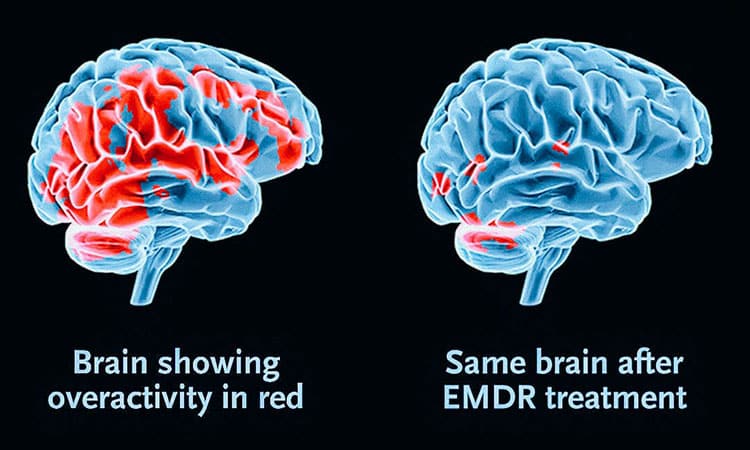A Guide to Trauma Recovery for High-Functioning Professionals
EMDR (Eye Movement Desensitization and Reprocessing) is a form of therapy that helps people heal from trauma by using bilateral stimulation—like guided eye movements—to help the brain reprocess and store disturbing memories in a healthier way.
Why So Many High-Functioning Professionals Are Turning to EMDR
You might look put-together on the outside—but inside, you’re mentally exhausted, emotionally worn down, and haunted by memories or patterns that won’t let go. You’ve achieved a lot, but something still feels off. Maybe you’ve tried talk therapy and found it insightful—but not transformative.
If that resonates, EMDR therapy may be the tool you didn’t know you needed.
This article explores how EMDR works in the brain, why it’s effective for high-functioning professionals with anxiety, burnout, or trauma-related symptoms, and what to expect from the process.
How Does EMDR Work in the Brain?
When the brain encounters overwhelming stress or trauma, it sometimes fails to “file” the memory properly. Instead, the memory stays raw—emotionally intense and physically reactive—making it easy to get triggered.
EMDR therapy and the brain connect through a process that mimics REM (rapid eye movement) sleep, where memories are naturally sorted and stored. During EMDR sessions, a therapist guides you through bilateral stimulation—typically side-to-side eye movements—while you briefly recall traumatic or disturbing moments.
This allows your brain to reprocess stuck memories, moving them from an emotionally reactive state to a more neutral, resolved one.
It’s not about forgetting—it’s about releasing. EMDR gives the brain the conditions it needs to heal trauma neurologically, not just emotionally.
Who Benefits Most From EMDR?
EMDR is particularly effective for:
- Professionals coping with chronic stress, anxiety, or burnout
- People with unresolved trauma from childhood or adulthood
- Those experiencing panic attacks, phobias, or performance blocks
- Clients who’ve tried talk therapy but feel stuck in recurring patterns
While EMDR is safe for most people, it’s not recommended during acute psychiatric crises or without a strong therapeutic foundation in dissociative conditions.
The Science Behind EMDR
Let’s look at the neuroscience behind how EMDR helps trauma:
- Amygdala: The brain’s alarm bell. EMDR reduces its hypersensitivity.
- Hippocampus: Manages memory and context. EMDR helps integrate traumatic memories into the past.
- Prefrontal Cortex: Your reasoning center. It becomes more engaged after EMDR, allowing clearer thinking and less reactivity.
Research using brain scans shows that EMDR brain healing is real. After EMDR treatment, the brain shows less activity in fear-based areas and greater integration across memory and emotion centers.
What to Expect During EMDR Therapy
The EMDR process follows eight structured phases:
- History & Planning
- Preparation with grounding tools
- Targeting specific memories
- Bilateral stimulation (eye movements, taps, tones)
- Installing new beliefs
- Body scans for lingering discomfort
- Closure and grounding
- Re-evaluation and next steps
Some clients report major shifts after just a few sessions; others work through a series of memories over time. Either way, EMDR is designed to produce lasting change.
Best Practices Before Starting EMDR
- Work with a certified EMDR therapist—ideally one trained through EMDRIA
- Start small. You don’t need to confront everything all at once
- Use grounding tools like breathing or visualization between sessions
- Be patient with integration. Sometimes you’ll feel worse before you feel better
- Stick with it. EMDR is powerful, but like physical therapy for the brain, it takes commitment
Myths vs. Facts About EMDR
Myth: EMDR is hypnosis.
Fact: EMDR doesn’t put you under—you’re awake and in control the whole time.
Myth: You must relive everything in detail.
Fact: You focus on key parts of the memory. Verbal detail isn’t necessary.
Myth: It only works for PTSD.
Fact: EMDR also helps with anxiety, grief, phobias, and self-esteem issues.
Frequently Asked Questions
How is EMDR different from talk therapy?
Talk therapy involves insight and analysis. EMDR activates the brain’s processing systems directly—helping you change how your brain stores the memory, not just how you think about it.
What kind of trauma does EMDR treat?
Everything from “big T” traumas like assault or accidents to “small t” experiences like bullying, humiliation, or chronic stress.
Can EMDR be done virtually?
Yes. Many therapists offer EMDR online using visual or auditory stimulation methods.
How fast does EMDR work?
Some clients feel better in a few sessions. Others need more time depending on the complexity of the trauma. EMDR often works faster than traditional therapy.
Ready to Explore EMDR Therapy?
If you’re a high-achieving professional stuck in cycles of anxiety, burnout, or distress—EMDR could help you finally move forward. Schedule a consultation today or explore our EMDR resources to learn more about how EMDR works in the brain and whether it’s the right fit for you.



